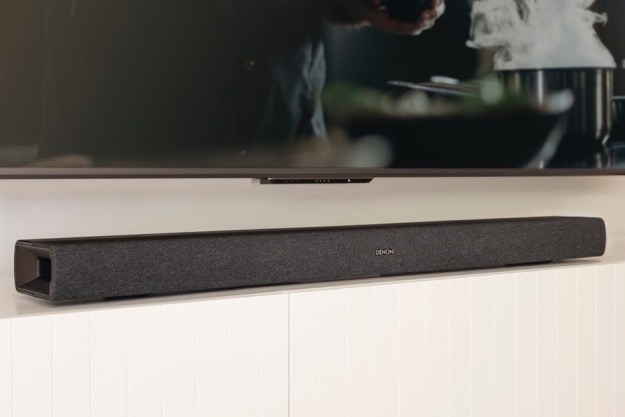“It consumes much less space than a conventional A/V receiver, but it doesn't come close to delivering the same audio experience.”
- Attractive design
- powerful amplifier
- multiple inputs
- Doesn't deliver a true surround-sound experience
- not enough bass response
Summary
LCD and plasma technology have enabled TVs to get wider in inverse proportion to their thickness, which can make the audio side of the home-theater equation stick out like a sore thumb. Denon’s $500 DHT-FS5 promises to deliver an authentic surround-sound experience from a single, low-profile box. And while it doesn’t completely replicate what a true surround system is capable of, it comes pretty close.
Features and Design


Denon DHT-FS5 Connections
Our Test Environment
We evaluated the DHT-FS5 in a 250-square-foot home theater, a room-within-a-room design constructed of four 2×4-framed walls inside four 2×6-framed walls, with two layers of R19 insulation stuffed in the dead space between them. The walls and ceiling are covered by two layers of sheetrock with sound-deadening caulk sandwiched between them, and the front wall is canted by three degrees to help prevent the formation of standing waves (a trick we learned from someone who designed demo rooms for consumer electronics retailers). We placed the speaker at the base of a 42-inch ViewSonic N4285P LCD television, and connected it to the coaxial digital-audio output of a home-theater PC. We played Spiderman 3 on the PC’s Pioneer BD202MR Blu-ray drive for our source material.
The DHT-FS5 has settings for three room sizes – 108 square feet, 172 square feet, and 215 square feet – so you can roughly tailor the speaker’s performance to your particular environment. We used the third setting and found that the device’s 150-watt amplifier was very much up to the task of filling the room with sound. The DHT-FS5 has four surround modes – movie, stereo, music, and news – that adjust the sound stage to suit the source material. We preferred the stereo mode for listening to music, which creates a sound stage typical of a pair of conventional stereo speakers. In our view, it did the best job of rendering the audio experience that the musicians and engineers in the studio originally sought to create.

Denon DHT-FS5
A Thin Illusion

The human ear and brain are extremely capable of locating a sound’s origin, so it’s very difficult for a speaker in the front of a room to fool them into perceiving sounds as originating from the back of the room. The DHT-FS5 did a good job of expanding the sound stage, but it never fooled us into believing that we were truly surrounded by sound. There are two chapters in Spiderman 3 in which this became most readily apparent: The first is the one in which James Franco’s character is pursuing Tobey Maguire (Spiderman). Franco is flying on a jet-powered skateboard, and he hurls explosive globes at Spiderman. Watching this scene on a true 5.1-channel sound system, we could hear the globes whiz toward us and past us before exploding behind our heads. On the Denon system, their sound traveled about halfway up the wall and stopped. That’s an impressive accomplishment for a single-cabinet speaker system, but it’s just not the same.
The Denon had even more trouble with the second action scene. This time, Thomas Haden Church’s character falls into a sand pit in which scientists are about to conduct some sort of particle-accelerator experiment. As these three huge vertical arms begin spinning around him, the audience is supposed to feel as though they’re sitting in the middle of the resulting vortex, with these mechanical arms whirling around their heads. The DHT-FS5 moved the sound from left to right, but our ears were never fooled into perceiving that we were in the middle of that sound stage.

Denon DHT-FS5
Conclusion
The Denon DHT-FS5 weighs only 11 pounds, so it can be easily hung beneath a wall-mounted TV, provided you have a power outlet nearby (most people will need to have an outlet installed; so while you have the wall open, run a cable to a subwoofer). It does a good job of simulating a surround-sound system, and it consumes much less space than a conventional A/V receiver and six speakers. But it doesn’t come close to delivering the same audio experience as those components.
Pros:
- Attractive form factor
- Plenty of power for a moderately sized home theater
- Multiple inputs
- Preamp subwoofer output
Cons:
- Can’t match the performance of a true surround-sound system
- Can’t decode Dolby TrueHD or DTS-HD Master Audio
- Inadequate bass response
Editors' Recommendations
- The 5 best soundbars for Samsung TVs in 2024
- Updating our Sony WF-1000XM5 review
- Nura’s personalized earbuds are reborn as the Denon Perl
- Denon snaps up Nura, says new personalized-sound earbuds arriving this year
- Denon updates 8K AV receivers with prices starting at $399


